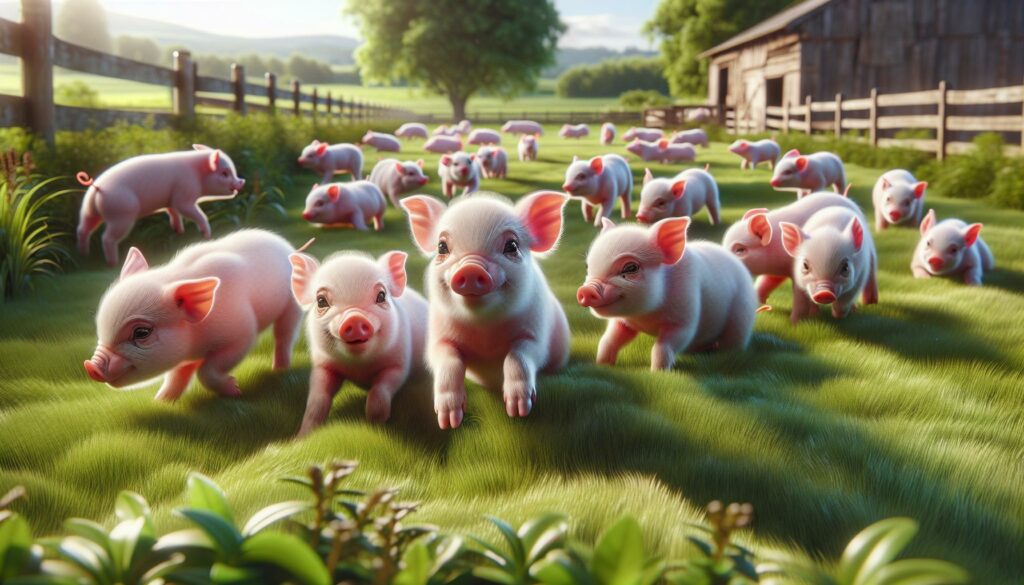When I first stumbled upon the concept of baby:s4eojlqturs= pig, I couldn’t help but feel a mix of curiosity and excitement. This intriguing term opens up a world of adorable imagery and fascinating insights into the lives of baby pigs. These little creatures are not just cute; they’re also packed with personality and charm that can brighten anyone’s day.
As I dive deeper into this topic, I’ll explore the unique characteristics of baby pigs, their behaviors, and why they’ve captured the hearts of so many. Whether you’re a farm enthusiast or simply someone who loves cute animals, understanding the world of baby pigs offers a delightful glimpse into their playful lives. Join me as we uncover what makes these tiny animals so special and why they deserve a place in our hearts.
- Adorable Personality: Baby:s4eojlqturs= Pigs, or piglets, are known for their playful and affectionate nature, making them delightful companions for both farms and households.
- Rapid Growth: Piglets typically weigh 2-3 pounds at birth and can exceed 50 pounds within just a few months, showcasing their remarkable growth rates.
- Social Creatures: Piglets exhibit strong social behaviors, forming close bonds with humans and other animals through vocalizations and playful interactions.
- Balanced Diet: Proper nutrition is critical for piglets, transitioning from their mother’s milk to solid foods high in protein and nutrients to support healthy development.
- Health Vigilance: Common health issues include diarrhea, respiratory problems, and parasitic infections, necessitating routine veterinary care and vaccinations for optimal health.
- Safe Environment: Ensuring a clean, spacious, and comfortable living space helps promote physical activity and overall well-being for baby pigs.
Baby:S4Eojlqturs= Pig
Baby:s4eojlqturs= Pigs, often referred to as piglets, are known for their playful and affectionate nature. These young animals typically weigh around 2-3 pounds at birth and grow rapidly. Within just a few months, they can weigh over 50 pounds. Their distinct characteristics include large, expressive eyes, soft skin, and tiny, adorable snouts, which contribute to their irresistible charm.
Piglets exhibit highly social behavior, forming close bonds with both humans and other animals. They communicate using a variety of vocalizations, expressing excitement, fear, and curiosity. Their intelligence is remarkable, as they can learn various tricks and commands, often showcasing problem-solving skills similar to dogs.
In terms of diet, baby pigs primarily consume their mother’s milk for the first few weeks. As they grow, they gradually transition to solid food, including grains, fruits, and vegetables. Proper nutrition during these early stages is crucial for their growth and health, helping them develop strong bones and muscles.
Overall, the distinctive traits and engaging personalities of baby pigs resonate with many, making them beloved companions for various households and farms.
Visual Characteristics
Baby:s4eojlqturs= Pigs, or piglets, exhibit several notable physical traits that enhance their appeal. From size to color variations, each characteristic contributes to their endearing presence.
Size and Weight
Piglets typically weigh around 2-3 pounds at birth. They experience rapid growth, often reaching over 50 pounds within a few months. As they mature, they can grow to sizes between 100 and 250 pounds, depending on the breed. Their compact stature, larger heads relative to their bodies, and sturdy legs make them look particularly charming as they play and explore.
Color Variations
Piglets come in a range of color variations, adding to their visual charm. Common colors include:
- Pink: The most recognizable hue, often associated with farm pigs.
- Black: Solid black piglets or those with varying patterns display deep, glossy fur.
- Spotted: Patterns of black and white or brown and white create a unique visual appeal.
- Brown: Reddish-brown or chocolate-brown fur encompasses another delightful variation.
These color differences not only enhance their visual charm but also contribute to their individuality within litters.
Behavior and Temperament
Baby:s4eojlqturs= Pig, also known as piglets, display captivating behaviors that reflect their lively nature. Understanding their temperament and social dynamics provides insight into their delightful personalities.
Social Interactions
Piglets exhibit strong social inclinations, forming close bonds with both humans and other animals. They communicate through a range of vocalizations, including squeals, grunts, and snorts, which convey their feelings and establish connections. In a group setting, piglets engage in hierarchical social structures, often demonstrating playful dominance and submission as they interact with one another. The presence of companionship is vital; piglets thrive when socializing with their siblings or other pets, reducing stress and boosting overall happiness.
Playfulness
Playfulness characterizes a piglet’s demeanor, showcasing their curiosity and intelligence. They engage in various playful activities, such as chasing, wrestling, and exploring their environment. This playful behavior not only entertains but also facilitates physical development and cognitive growth. Piglets often exhibit a penchant for toys and objects, demonstrating their ability to learn problem-solving skills and tricks through play. Their playful antics captivate observers, making them enjoyable companions on farms and in homes.
Care and Maintenance
Providing proper care and maintenance for baby pigs ensures their healthy growth and development. Attention to feeding requirements and their living environment fosters happy and thriving piglets.
Feeding Requirements
Piglets require a balanced diet that supports their rapid growth. Initially, they depend on their mother’s milk for essential nutrients. After about three to four weeks, I introduce solid food, specifically piglet starter feeds formulated for young swine. These feeds contain vital ingredients like protein, vitamins, and minerals, which promote healthy weight gain. It’s crucial to gradually transition them to adult pig feeds between two to six months. Fresh water must always be available, ensuring proper hydration. Monitoring their weight and adjusting food portions based on the breed, age, and activity level guarantees optimal nutrition and health.
Living Environment
Creating a safe and comfortable living environment is vital for baby pigs. I ensure their space is clean, dry, and protected from harsh weather. Piglets thrive in temperatures between 70°F to 75°F, so adequate bedding made of straw or wood shavings helps with insulation. The enclosure should substantially reduce exposure to potential hazards, allowing piglets to explore without risks. Providing plenty of space to roam encourages physical activity, crucial for development. Additionally, social interactions should be fostered by keeping multiple piglets together, as they are naturally social animals. Regular cleaning of their living area helps maintain hygiene and prevents illness, promoting long-term health.
Health Considerations
Care for piglets includes awareness of health issues and veterinary needs. Addressing these factors ensures a thriving environment for baby pigs.
Common Health Issues
Piglets are susceptible to several health issues, particularly in their early weeks. Common problems include:
- Diarrhea: Often caused by dietary changes or infections, diarrhea can lead to dehydration. Maintaining proper nutrition and ensuring access to clean water helps prevent this issue.
- Respiratory Problems: Piglets can develop respiratory infections due to poor ventilation or exposure to drafts. Keeping living spaces clean and ensuring proper airflow reduces these risks.
- Parasitic Infections: Worms and other parasites may infest piglets, impacting their growth. Regular deworming protocols can control and prevent such infections, improving their overall health.
- Swine Flu and Other Viral Infections: Piglets can contract illnesses like swine flu. Vaccinations and biosecurity measures are crucial to shield against such diseases.
Being vigilant about these potential health issues promotes healthier, happier piglets.
Veterinary Care
Routine veterinary care plays a significant role in maintaining the health of piglets. Key practices include:
- Regular Check-Ups: Scheduling routine veterinary visits allows for early detection of health problems. A professional can assess growth, weight, and overall condition to ensure piglets thrive.
- Vaccination: Administering vaccinations as advised protects against common diseases. Following a veterinarian’s vaccination schedule optimizes piglet health.
- Nutritional Guidance: Collaborating with a veterinarian helps establish appropriate feeding plans tailored to each piglet’s needs. They provide insights on transitioning from milk to solid foods effectively.
- Emergency Care: Knowing the signs of distress or illness is vital. Quick communication with a veterinarian during emergencies can save lives.
Investing in veterinary care not only prevents health issues but also ensures piglets grow into robust adult pigs.
Baby:s4eojlqturs= Pig are truly remarkable creatures that capture our hearts with their playful nature and charming personalities. Their intelligence and social behaviors make them not just adorable but also engaging companions. I’ve found that understanding their needs for nutrition and a safe environment is essential for fostering their growth and happiness.
As I continue to learn about these delightful animals, I appreciate the joy they bring to both farms and homes. Whether you’re considering adding a piglet to your family or simply enjoying their cuteness from afar, baby pigs undoubtedly hold a special place in our lives.

